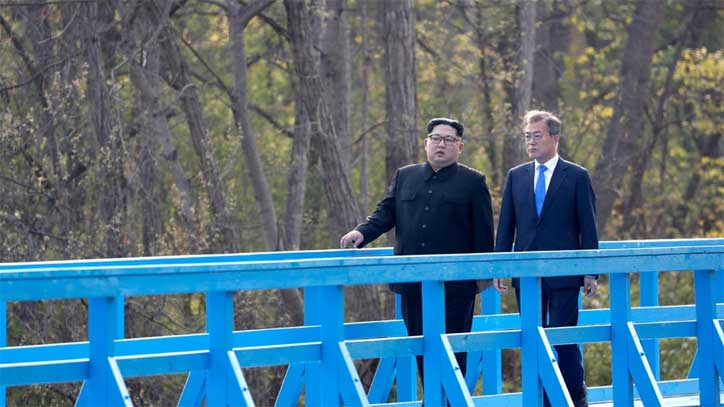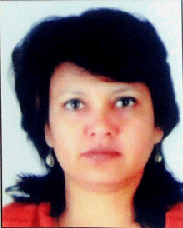 Seoul:
Seoul: North Korean leader Kim Jong Un has vowed to shut down the country’s nuclear test site in May and open the process to experts and journalists from South Korea and the United States, Seoul’s presidential office said on Sunday.
Kim made the comments during his summit with South Korean President Moon Jae-in on Friday at a border truce village, where he also expressed optimism about his anticipated meeting with Donald Trump, saying the US president will learn he’s “not a person” to fire missiles toward the United States, Moon’s spokesman Yoon Young-chan said.
Moon and Kim during the summit promised to work toward the “complete denuclearization” of the Korean Peninsula, but made no references to verification or timetables. Seoul had also shuttled between Pyongyang and Washington to set up a potential meeting between Kim and Trump, which is expected next month or early June. “Once we start talking, the United States will know that I am not a person to launch nuclear weapons at South Korea, the Pacific or the United States,” Yoon quoted Kim as saying.
“If we maintain frequent meetings and build trust with the United States and receive promises for an end to the war and a non-aggression treaty, then why would be need to live in difficulty by keeping our nuclear weapons?” Yoon quoted Kim as saying. North Korea this month announced it has suspended all tests of nuclear devices and intercontinental ballistic missiles and plans to close its nuclear testing ground.
Kim reacted to skepticism that the North would only be closing down the northernmost test tunnel at the site in Punggye-ri, which some analysts say became too unstable to conduct further underground detonations following the country’s sixth and most powerful nuclear test in September. In his conversation with Moon, Kim denied that he would be merely clearing out damaged goods, saying that the site also has two new tunnels that are larger than previous testing facilities, Yoon said. Yoon said Kim also revealed plans to re-adjust its current time zone to match the South’s.
The Koreas used the same time zone for decades before the North in 2015 created its own “Pyongyang Time” by setting the clock 30 minutes behind South Korea and Japan. North Korean then explained the decision as an effort to remove a legacy of Japanese colonial rule. Local time in South Korea and Japan is the same — nine hours ahead of Greenwich Mean Time. It was set during Japan’s rule over the Korean Peninsula from 1910 to 1945. Yoon said that the North’s decision to return to the Seoul time zone was aimed at facilitating communication with South Korea and also the United States.
Suh Hoon, the man who set up Korean summit was also behind the previous twoShedding tears behind South Korean President Moon Jae-in and North Korea’s Kim Jong Un after the two leaders announced a historic agreement on Friday was a man who has worked for two decades to set up unlikely dialogue between old enemies.
Nearly 18 years after Suh Hoon, a South Korean intelligence official, travelled to Pyongyang to persuade reclusive North Korean leader Kim Jong-il to hold an unprecedented summit in the North Korean capital in 2000, he watched Kim’s son pledging peace on the Korean peninsula on Friday — this time just south of the heavily militarised border.
Friday was the first time any North Korean head of state set foot on South Korean soil since the 1950-53 Korean War left the country divided.
The landmark encounter came less than a year after South Korea’s President Moon took office and quickly tapped Suh as chief of the National Intelligence Service, saying he was “the right person” to revive inter-Korean ties strained over North Korea’s pursuit of nuclear-armed missiles.
“It is too premature to talk about a next inter-Korean summit,” Suh said last year after his appointment was announced, returning him to the agency he quit in 2008 when a conservative government was elected. “But we need it.”
Suh, who personally helped arrange two previous inter-Korean summits in 2000 and 2007, is viewed as the country’s top expert on North Korea. He is known as the South Korean who met with late North Korean leader Kim Jong-Il the most.
Lee Jong-seok, a former unification minister who visited Pyongyang with Suh in 2003 as then-South Korean president Roh Moo-hyun’s special envoys, called Suh the “No. 1 negotiator with North Korea” in his 2014 memoir.
Suh, 64, also lived in North Korea for two years in the late 1990s, involved in a plan to build a nuclear reactor as part of a 1994 international deal to freeze Pyongyang’s nuclear programmes. That deal eventually collapsed. “He came in knowing already how it works and what to do,” said John Delury, a North Korea expert. The presidential Blue House declined to comment on Suh’s role. The intelligence service could not be reached for comment.
In March, he was part of the 10-member delegation that visited third-generation leader Kim Jong-un, becoming one of the first South Korean officials to meet Kim since he took power in 2011.
At the meeting, Kim not only agreed to meet Moon but also stunned Suh and other envoys by saying he would be willing to discuss denuclearisation with US President Donald Trump. Suh later also arranged a trip to Pyongyang for his US counterpart, Mike Pompeo, to meet Kim from March 31 to April 2, and lay the groundwork for the planned summit, US officials said.
Suh was one of two officials Moon picked to join his first official dialogue with Kim. “Just seeing Suh in there spoke volumes about the important role he played in setting up the summit,” said Seo Yu-suk, research manager at the Institute of North Korean Studies in Seoul.
 Seoul: North Korean leader Kim Jong Un has vowed to shut down the country’s nuclear test site in May and open the process to experts and journalists from South Korea and the United States, Seoul’s presidential office said on Sunday.
Seoul: North Korean leader Kim Jong Un has vowed to shut down the country’s nuclear test site in May and open the process to experts and journalists from South Korea and the United States, Seoul’s presidential office said on Sunday.